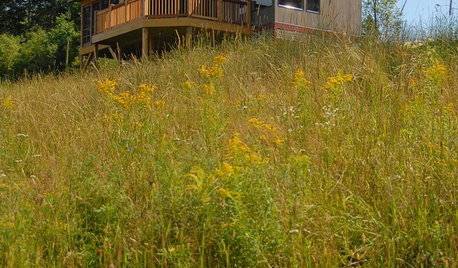Eroding Hillside Challenge
lovelycherry
17 years ago
Related Stories

GUESTHOUSESHouzz Tour: A Lakeside Guesthouse Rises to the Challenge
To keep flat ground for entertaining, the architects of this Mercer Island cabin on a hillside looked upward
Full Story
HOUZZ TOURSMy Houzz: Hillside Sanctuary in Vermont
A couple designs a peaceful retreat with thoughtful, sustainable materials and spiritual spaces in which to meditate
Full Story
ARCHITECTUREHow to Artfully Build a House on a Hillside
Let your site's slope inspire your home's design, rather than fight it
Full Story
INSPIRING GARDENSSmart Plantings Grace a Hillside Garden
Fire-wise and low-water plants create a lush backdrop for bocce playing, swimming and hanging out by the fire
Full Story
CONTEMPORARY HOMESHouzz Tour: Family Builds Its Dream Home on a Wooded Hillside
Light-filled spaces and modern furnishings suit an active family in a California foothill community
Full Story
HOUZZ TOURSHouzz Tour: Stunning Desert Hillside Home in Arizona
An extraordinary, expansive home near Phoenix celebrates and interacts with the beauty of its natural surroundings
Full Story
HOUZZ TOURSHouzz Tour: A Hollywood Writer's Hillside Studio
Step Inside a Writer's Modern Workshop With a Big-Screen View
Full Story
LANDSCAPE DESIGNHow to Design a Great Garden on a Sloped Lot
Get a designer's tips for turning a hillside yard into the beautiful garden you’ve been dreaming of
Full Story
HOUZZ TOURSMy Houzz: Pure Simplicity Reigns in Salt Lake City
Minimalist style puts dynamic architecture and hillside views front and center in a renovated Utah home
Full StorySponsored







lovelycherryOriginal Author
lovelycherryOriginal Author
Related Professionals
Ballwin Landscape Architects & Landscape Designers · Suffern Landscape Architects & Landscape Designers · Wixom Landscape Architects & Landscape Designers · McKinney Landscape Contractors · Norwood Landscape Contractors · Edwardsville Landscape Contractors · Fair Oaks Landscape Contractors · Kearny Landscape Contractors · Leicester Landscape Contractors · Merced Landscape Contractors · Northbridge Landscape Contractors · Reedley Landscape Contractors · Sammamish Landscape Contractors · Wentzville Landscape Contractors · Quartz Hill Landscape ContractorslovelycherryOriginal Author
User
lovelycherryOriginal Author
bob64
lovelycherryOriginal Author
bob64
lovelycherryOriginal Author
bob64
lovelycherryOriginal Author
toolilycrazy
lovelycherryOriginal Author
bob64
lovelycherryOriginal Author
lovelycherryOriginal Author
bob64
jeanner
bob64
lovelycherryOriginal Author
jeanner
lovelycherryOriginal Author
bob64
lovelycherryOriginal Author
madtripper